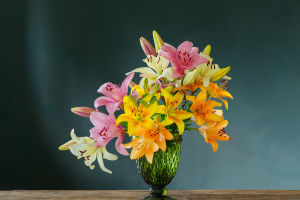Tulips are beautiful and symbolic flowers that bring life and color to spring.
Originally cultivated in the highlands of Central Asia, tulips eventually made their way around the globe.
They are grown in different climates, especially in the Netherlands, where they have become a symbolic flower.The growth process of tulips begins in autumn when growers plant the bulbs of tulips in the soil in late autumn. Unlike other flowers, the bulbs of tulips store enough nutrients to bloom smoothly in the spring. When planting, farmers choose a place with sufficient light but not direct exposure to the sun to ensure that the tulips have a good growing environment.
In winter, the bulbs are dormant and quietly accumulate energy in the soil to prepare for blooming in the spring. In spring, as the temperature gradually warms up, tulips begin to sprout green buds from the ground. .It's amazing to finally be able to see indicators that the tulips are going to blossom after months of waiting. As time goes by, the leaves of the tulips begin to unfold, and then the buds begin to appear. The process of a bud slowly expanding from a newly emerged bud to a complete tulip flower appearing in front of people is full of magical beauty.
Tulips are very colorful, with many colors such as red, yellow, pink, white, purple, and even some varieties with stripes or spots. These different colors not only bring visual diversity to the garden but also provide people with a rich means of expressing emotions. Red tulips symbolize passionate love, yellow is often considered to represent friendship and sunshine, and white tulips symbolize purity and innocence. Tulips are a perfect present option for a variety of festivals and anniversaries because each colour has a distinct meaning.
As spring deepens, the flowers of tulips gradually open up completely, showing their gorgeous colors and elegant shapes. Although tulips look delicate, they have a unique toughness. They can sway in the breeze, but they will not wither easily. Tulip petals are usually cup-shaped or bowl-shaped, which makes them shine in the sun, like a cup full of spring vitality. This unique beauty has also made tulips the inspiration for many works of art, from paintings to poems, the image of tulips is everywhere.
The Netherlands played an important participant in the history of tulips. One of the most well-known tulip-related historical occurrences is the 17th-century "Tulip Mania". During that period, the price of tulip bulbs soared, and at one point it was even more expensive than gold. This frenzy of speculation later subsided, but it made tulips occupy a unique position in Dutch culture. Today, the Netherlands is still the world's largest producer of tulips. Every spring, thousands of tourists flock to the tulip fields in the Netherlands to enjoy the endless sea of flowers.
These flower fields are like pieces of colorful patchwork, covering the vast fields, which is breathtaking. In addition to its ornamental value, tulips also have certain medicinal value. Historically, some cultures used tulips to treat skin diseases and relieve symptoms such as sore throats. Although modern medicine does not widely use tulips as medicine, it is still part of some traditional herbal remedies. In addition, tulip petals can also be used to make beauty products such as perfumes and essential oils, which makes it also have a place in the cosmetics field.
The beauty of tulips is not only reflected in their flowers but also contains profound natural wisdom throughout their life cycle. From sowing in autumn, and dormancy in winter, to blooming in spring, the life of a tulip is a process of patiently waiting, accumulating energy, and finally blooming. This cyclical change makes people think of the journey of life: each stage has its unique meaning, and only after a long period of accumulation and precipitation can the most beautiful moment finally come.
Tulips are not just beautiful flowers, they carry a deep cultural background, historical stories, and symbolic meanings. Whenever a tulip blooms, it seems to announce to the world: that spring has arrived and good times are just around the corner. This flower full of vitality and hope will continue to bring beauty and inspiration to people in the years to come.


